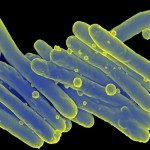Lien vers Pubmed [PMID] – 14736915
Proc. Natl. Acad. Sci. U.S.A. 2004 Feb;101(5):1345-9
Mycobacterium ulcerans (MU), an emerging human pathogen harbored by aquatic insects, is the causative agent of Buruli ulcer, a devastating skin disease rife throughout Central and West Africa. Mycolactone, an unusual macrolide with cytotoxic and immunosuppressive properties, is responsible for the massive s.c. tissue destruction seen in Buruli ulcer. Here, we show that MU contains a 174-kb plasmid, pMUM001, bearing a cluster of genes encoding giant polyketide synthases (PKSs), and polyketide-modifying enzymes, and demonstrate that these are necessary and sufficient for mycolactone synthesis. This is a previously uncharacterized example of plasmid-mediated virulence in a Mycobacterium, and the emergence of MU as a pathogen most likely reflects the acquisition of pMUM001 by horizontal transfer. The 12-membered core of mycolactone is produced by two giant, modular PKSs, MLSA1 (1.8 MDa) and MLSA2 (0.26 MDa), whereas its side chain is synthesized by MLSB (1.2 MDa), a third modular PKS highly related to MLSA1. There is an extreme level of sequence identity within the different domains of the MLS cluster (>97% amino acid identity), so much so that the 16 ketosynthase domains seem functionally identical. This is a finding of significant consequence for our understanding of polyketide biochemistry. Such detailed knowledge of mycolactone will further the investigation of its mode of action and the development of urgently needed therapeutic strategies to combat Buruli ulcer.

